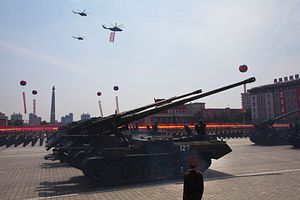During last week’s high-level cross-border military talks, North Korean officers allegedly suggested the removal of long-range artillery pieces from the military demarcation line — the de-factor border between North and South Korea running near the 38th parallel — to areas 30 to 40 kilometers to the rear, according to local media reports.
The talks, taking place in the border village of Panmunjom in the demilitarized zone (DMZ), involved two-star generals from the Republic of Korea Armed Forces and the Korean People’s Army. It was the first military-to-military dialogue between the two sides in over a decade and a follow up on the Panmunjom Declaration from the April 27 inter-Korean summit at the border village.
According to a source, the North Korean delegates during the talks brought up first the possible removal of long-range artillery pieces “as a matter of principle.” However, another source speaking to South Korea media suggested that it was the South Koreans who initiated discussions on the removal of long-range artillery from the border.
“[W]e have to craft measures to drastically reduce military tensions by removing practical threats,” the source told The Korea Times. “I understand that (the South) suggested moving the North’s artillery that threatens the Seoul metropolitan area to rear areas so as to actively implement the Panmunjom Declaration.”
South Korea’s Ministry of Defense denied that it proposed the movement of North Korean artillery pieces away from the DMZ. In a separate article, The Korea Times notes that “sources said the North virtually accepted the suggestion so it can be discussed in follow-up talks.” Importantly, however, the article states that “the North called on the South’s military and United States Forces Korea (USFK) to take reciprocal steps.”
For example, North Korea could push for the removal of the dozens of U.S.-made surface-to-surface precision-guided Army Tactical Missile Systems (ATACMS). ATACMS is a surface-to-surface missile with an estimated range of around 300 kilometers and is capable of hitting the North Korean capital Pyongyang. U.S. and South Korean militaryrepeatedly test fired ATACMS in response to North Korean ballistic missile launches last year.
The fact that the North purportedly only suggested the removal of long-range artillery systems rather than medium or short-range guns suggests that it primarily wants to reduce the artillery threat against Pyongyang (even though with a distance of 195 kilometers from the DMZ, the North Korean capital would still be in range of ATACMS and other long-range surface-to-surface missiles.)
Additionally, North Korea could also push for the removal of U.S. “strategic assets” from the vicinity of the Korean Peninsula.
As I wrote earlier this month (See: “Trump-Kim Summit: Why North Korea’s Conventional Threat to South Korea Should Be Discussed in Singapore”), North Korea’s mid-and-long-range artillery force is capable of unleashing a devastating level of destruction against the Seoul metropolitan area and other parts of South Korea:
Overall, North Korea is estimated to be capable of fielding over 6,000 artillery systems in the mid-and-long-range category, a large number of which is deployed in hardened facilities (over 4,000 according to one estimate) providing added protection from so-called counter-battery fire in close proximity to the demilitarized zone (DMZ). This includes over 1,440 122-millimeter self-propelled (SP) guns with an estimated range of 15 kilometers, around 430 170-millimeter M-1978 Koksan SP guns with a maximum firing range of 60 kilometers, and an estimated 35-38 KN-09 300-millimeter multiple rockets launchers capable of hitting targets at a distance of up to 200 kilometers. These guns are thought to be capable of firing 10,000 rounds per minute at Seoul.
Notably, removing North Korean guns 30 to 40 kilometers to the rear would not eliminate the North’s artillery threat as longer-range systems could still shell South Korean territory. The question also arises how the possible removal of North Korean artillery pieces would be verified by the South. Would North Korea allow the establishment of strong verification mechanisms including on-site inspections? Furthermore, even if removed, it should be noted that most artillery systems could be quickly returned to their positions should the North Korean military wish to do so. For now, the offer, if it turns out to be true, appears to be largely a political gesture.
































